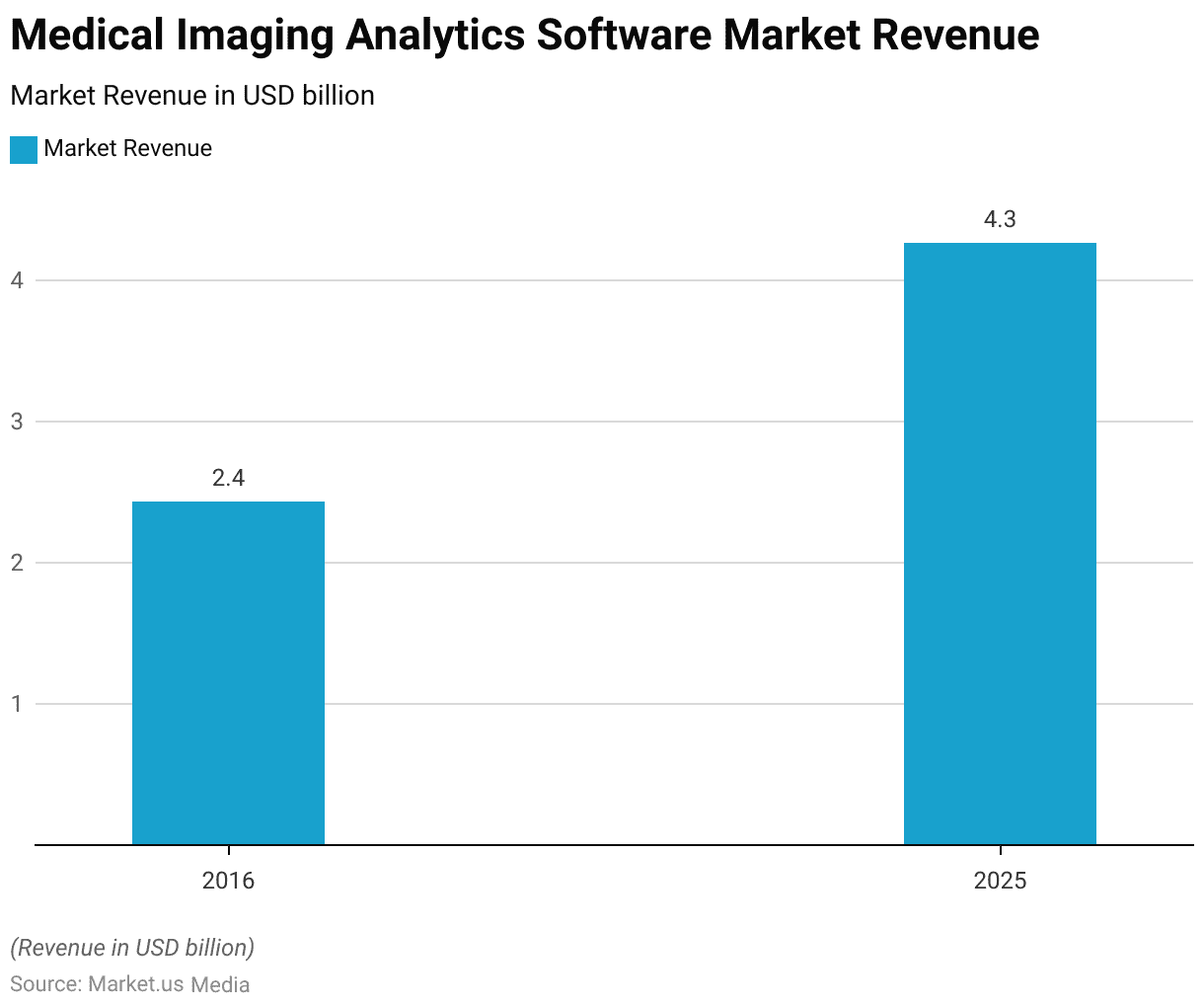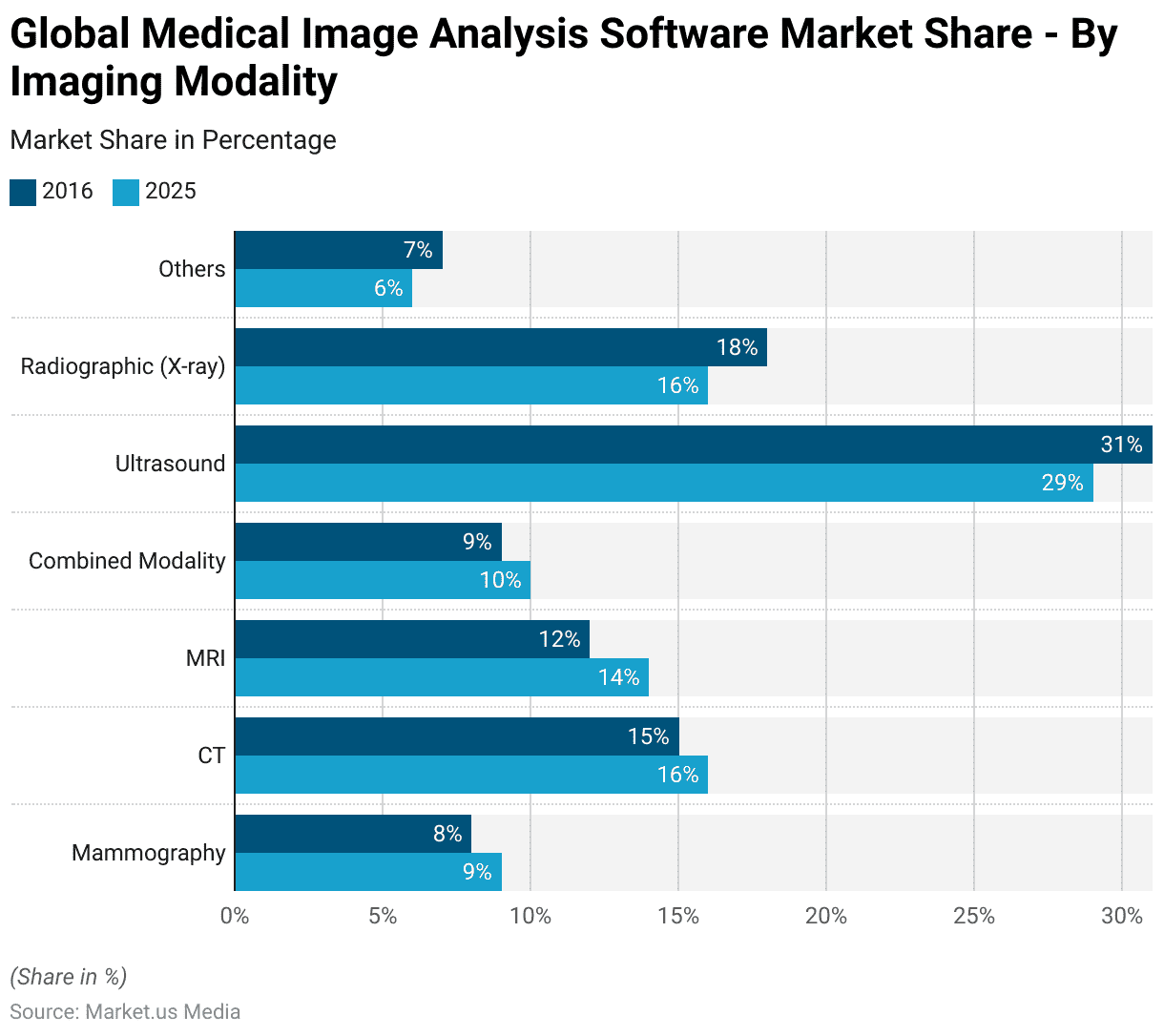Table of Contents
Introduction
According to Medical Image Analysis Software Statistics, Medical Image Analysis Software plays a vital role in contemporary healthcare by assisting healthcare experts in precise diagnosis, treatment strategy development, and research activities. It improves image clarity, identifies particular areas of interest, and delivers exact measurements.
Notable trends encompass its smooth incorporation into healthcare systems, reliance on cloud-based solutions, and the rise of personalized medical approaches. Obstacles encompass data security and adherence to regulations.
Nonetheless, the software’s future looks bright, fueled by technological advancements and the increasing need for precise medical solutions.
Editor’s Choice
- By 2025, the Medical Image Analysis Software market is expected to reach a revenue of USD 4.26 billion.
- By 2025, in terms of product distribution, standalone software’s market share is anticipated to decline to 37%, and integrated solutions will rise to a 42% share.
- Concerning imaging modality, Mammography, which accounted for 8% of the market share in 2016, is expected to see a slight increase to 9% by 2025.
- North America emerged as the leading region in 2016, with a market size of USD 780.8 million, and is expected to further expand its dominance, reaching USD 1,310.8 million by 2025.
- In 2021, the field of cardiology represented a substantial portion, accounting for 20%, of the radiology image analysis software market.
- In 2022, an estimated 28,600 women in Canada received a breast cancer diagnosis, with a quarter of them being newly diagnosed cases.
- Between 2010 and 2013, there was a clear uptick in the percentage of X-rays and MRIs conducted within 30 days following the initial medical consultation.
Medical Image Analysis Software Market Overview
Global Medical Image Analysis Software Market Size
- The revenue generated by the Medical Imaging Analytics software market has exhibited significant growth over the years.
- In 2016, it stood at USD 2.43 billion, marking the beginning of its trajectory.
- Fast forward to 2025, and the market has experienced substantial expansion, reaching a revenue of USD 4.26 billion.

Global Medical Image Analysis Software Market Share- By Product
- The Global Medical Image Analysis Software market has witnessed notable shifts in product distribution over the years.
- In 2016, standalone software held a majority share at 63%, while integrated solutions accounted for 58% of the market.
- However, a significant transformation occurred by 2025, with standalone software’s market share declining to 37%, and integrated solutions rising to a 42% share.

Medical Image Analysis Software Market Share- By Imaging Modality
- In the global medical image analysis software market, an analysis of market share by imaging modality reveals interesting trends between 2016 and the projected figures for 2025.
- Mammography, which accounted for 8% of the market share in 2016, is expected to see a slight increase to 9% by 2025.
- CT imaging modality is poised to grow from 15% to 16% during this period.
- MRI, another critical imaging method, is also on the rise, going from 12% in 2016 to 14% in 2025.
- Combined modality imaging is anticipated to experience a minor increase, going from 9% to 10%.
- However, ultrasound, which had the largest market share in 2016 at 31%, is projected to see a slight decline to 29% by 2025.
- Radiographic (X-ray) imaging is expected to decrease from 18% in 2016 to 16% in 2025.

Global Medical Image Analysis Software Market Share- By Region
- The global medical image analysis software market exhibits notable regional variations in terms of market size, with data comparing 2016 figures to projected values for 2025.
- North America emerged as the leading region in 2016, with a market size of USD 780.8 million, and is expected to further expand its dominance, reaching USD 1,310.8 million by 2025.
- Europe, following closely behind, had a market size of USD 743.6 million in 2016 and is projected to reach USD 1,215.1 million by 2025.
- In the Asia Pacific region, the market was valued at USD 614 million in 2016 and is anticipated to grow significantly, reaching USD 1,146.1 million in 2025.
- Meanwhile, the Rest of the World region started at USD 125.5 million in 2016, and although it shows growth, it is still relatively smaller compared to the aforementioned regions, with a projected value of USD 264.7 million by 2025.

Applications of Medical Image Analysis Software
Cardiology
- In 2021, the field of cardiology represented a substantial portion, accounting for 20%, of the radiology image analysis software market.
- This correlation aligns with the fact that cardiovascular disease ranks as the second leading cause of death in Canada. Notably, advanced algorithms play a pivotal role in various aspects of cardiovascular image analysis.
- As a recent example, Cleerly Proxy, a software solution is designed to streamline the process of transferring CT angiograms from local systems to Cleerly’s cloud service.
Dentistry
- In dentistry, making decisions based on images poses a unique challenge due to the complex and compact structures within the oral cavity.
- The presence of numerous small and overlapping features, coupled with variations in tooth sizes, shapes, and positions, makes the analysis a daunting task.
- Fortunately, medical image analysis software has emerged as a valuable tool for dentists, enhancing both diagnostic accuracy and workflow.
- This software can identify issues like tooth decay and bone diseases such as osteoporosis. Furthermore, it proves invaluable in the design of orthodontic devices and dental prosthetics.
- For instance, consider 3Dme Crown, an automated crown design module. It utilizes AI technology and patient’s 3D scan data to swiftly generate a tailored crown prosthesis design that perfectly suits the patient’s oral conditions.
Neurology
- In the field of brain imaging, AI algorithms play a crucial role in aiding healthcare professionals to identify subtle brain abnormalities that would otherwise remain undetectable.
- Consider epilepsy, a condition affecting approximately 70 million individuals worldwide.
- Notably, for a third of those with epilepsy, conventional medications fail to control their seizures, and determining the most effective treatment for each patient remains a challenge for clinicians.
- In a clinical study conducted by epilepsy researchers in Canada, a machine-learning model was trained to analyze brain scans of epilepsy patients, even when no apparent signs of the condition were visible in standard MRI scans.
Breast Oncology
- In 2022, an estimated 28,600 women in Canada received a breast cancer diagnosis, with a quarter of them being newly diagnosed cases.
- Therefore, the accurate detection of tumors remains a critical aspect of breast imaging.
- Recent research published in The Lancet Digital Health indicates that when radiologists collaborate with AI assistance, their screening for breast cancer is more effective compared to working independently.
MIPAV Application
- The MIPAV software, which stands for Medical Image Processing, Analysis, and Visualization, supports the quantitative assessment and visual representation of medical images from various sources, including PET, MRI, CT scans, and microscopy.
- Utilizing MIPAV’s user-friendly interface and analytical tools, researchers located in different places can easily collaborate and exchange research data and analyses through the Internet.
- This capability amplifies their ability to engage in research, diagnose medical conditions, track progress, and devise treatment approaches.
- MIPAV functions as a Java application, ensuring compatibility with Java-enabled systems like Windows, UNIX, and Macintosh OS X.
Medical Image Analysis Software Usage Trends
- Between 2010 and 2013, there was a clear uptick in the percentage of X-rays and MRIs conducted within 30 days following the initial medical consultation.
- In both of these years, approximately 40% of lumbar spine X-rays and more than 60% of lumbar spine MRIs carried out within the initial 30-day timeframe were determined to be medically unnecessary.
- This same trend was evident in instances of knee and shoulder pain, with over 30% of MRIs considered inappropriate in both years, even when looking at a 60-day window.
- Patients who underwent these unnecessary MRIs were notably less inclined to undergo surgery for their condition within 90 days, implying a decreased sense of medical urgency compared to those for whom MRI imaging was deemed medically justified.
Medical Image Analysis Software Challenges
- In 2019, there were incidents of security breaches targeting medical protocols and file formats.
- Notable instances within the realm of PACS and medical imaging included instances like embedding malicious software within a DICOM image and the utilization of AI techniques to manipulate medical images.
- A German security firm named Greenbone Networks identified a concerning situation where nearly 24 million patient examinations, comprising over 720 million images, were left exposed on 187 insecure servers in the United States.
- Alarmingly, two months later, this number of exposed servers had doubled, leading to a serious breach of privacy.
- Consequently, the U.S. government imposed fines on several medical imaging companies, with one Tennessee-based company being required to pay a penalty of $3 million for inadvertently exposing a server containing the confidential data of over 300,000 patients.
Discuss your needs with our analyst
Please share your requirements with more details so our analyst can check if they can solve your problem(s)



